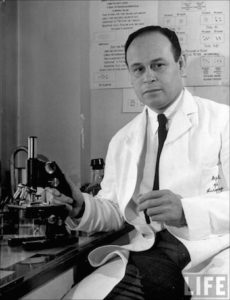
Dr. Charles R. Drew
On this date, in 1904, Charles Drew was born. He was a Black surgeon and hematologist who made pioneering discoveries about blood plasma and set up blood banks in the 1930s and 1940s.
Charles Richard Drew was the oldest of five children born in Washington, D.C., to Richard T. and Nora (Burrell) Drew. His father was a carpet layer, and his mother was a schoolteacher who graduated from Miner Teachers College. As a student, Drew excelled in academics and sports, winning four swimming medals by the age of eight. In 1922, he graduated from Dunbar High School, receiving the James E. Walker Memorial Medal in his junior and senior years for his athletic performance in football, basketball, baseball, and track.
Drew's accomplishments in sports at Dunbar High School earned him an athletic scholarship to Amherst College in Massachusetts, one of the nation's top liberal arts colleges. Drew was one of 16 Black students to graduate from Amherst from 1920 to 1929. He was athletic and a track team captain and collected several honors, including the Thomas W. Ashley Memorial Trophy for being the football team's MVP.
He served in World War II, worked with the American Red Cross, then returned to Howard University, where he taught and practiced surgery. Drew became interested in studying the vital fluid of life as a student at McGill University in Montreal, Canada, during the late 1920s and early 1930s. At that time, medical science had not yet determined how to preserve blood, a dilemma that became Drew's mission.
While interning at Presbyterian Hospital in New York City and pursuing a doctorate at Columbia University, Drew discovered that, unlike whole blood, which deteriorates after a few days in storage, blood plasma, the liquid portion of the blood without cells, can be preserved for long periods and substituted for whole blood in transfusions. In the late 1930s, Drew set up an experimental blood bank at Presbyterian Hospital and wrote a thesis titled “Banked Blood: A Study in Blood Preservation,” which earned him a Doctor of Science in Medicine from Columbia University in 1940.
Drew's medical breakthrough helped save thousands of lives by increasing the availability of blood to those in need of transfusions. Drew's discovery came at an opportune time. In 1939, World War II broke out in Europe, and by 1940, the British, in desperate need of blood to save the lives of injured soldiers, turned to the United States for help.
The Blood Transfusion Association chose Drew as the medical supervisor of the Blood for Britain program. Drew arranged for large amounts of plasma to be flown to England, and several blood banks were set up there. The American Red Cross enlisted Drew in 1941 to establish a blood bank program in the United States.
That same year, the U. S. War Department declared, "It is not advisable to collect and mix Caucasian and Negro blood indiscriminately for later administration to members of the military forces.” Drew protested the segregation of blood and resigned as director of the Red Cross Blood Bank Program. Not until 1949 did the U.S. military end the segregation of blood banks. Drew was awarded the NAACP's prestigious Spingarn Medal in 1944.
Following his World War II service and work with the American Red Cross, Drew returned to Howard University, where he taught and practiced surgery until he died in an automobile accident in 1950.